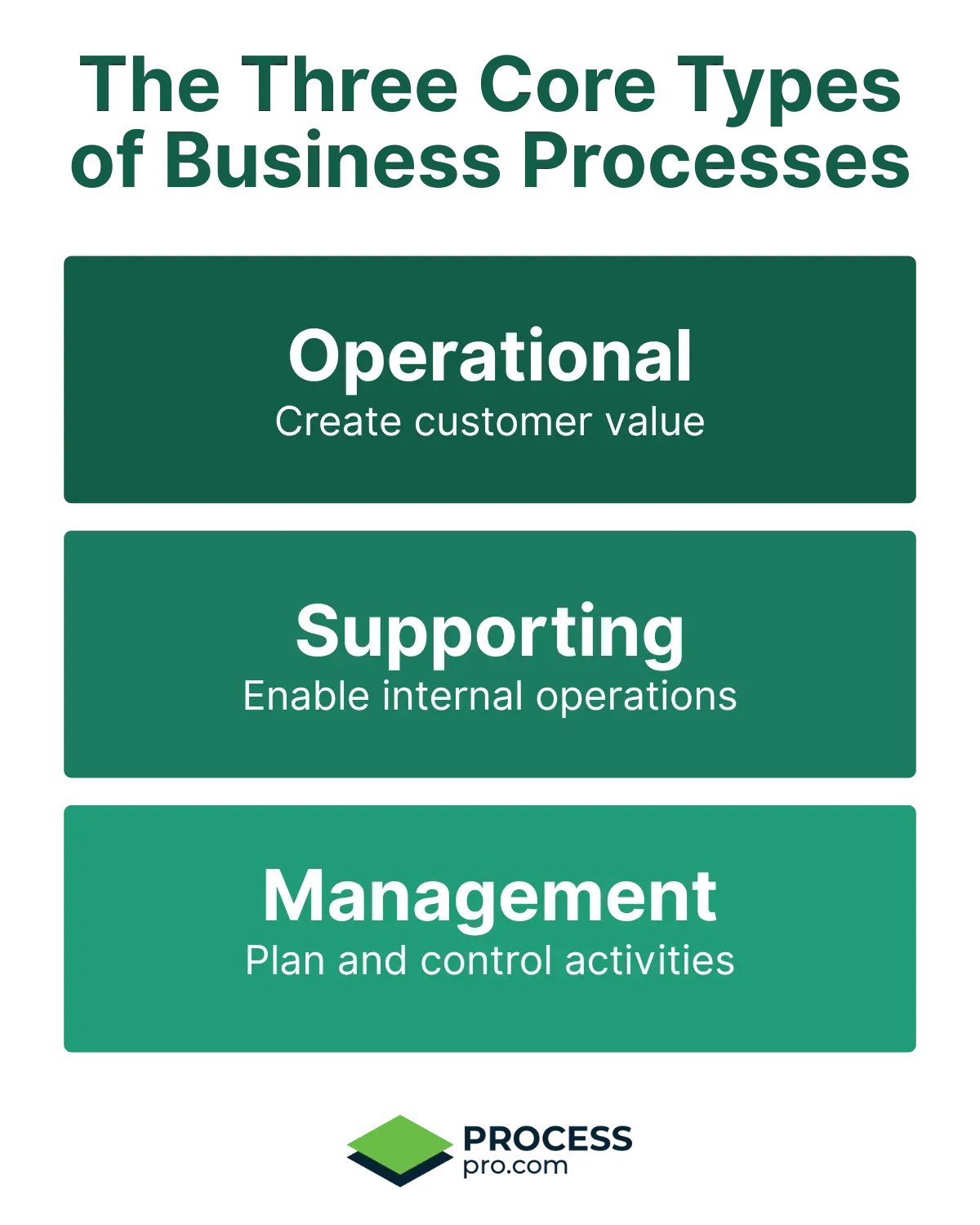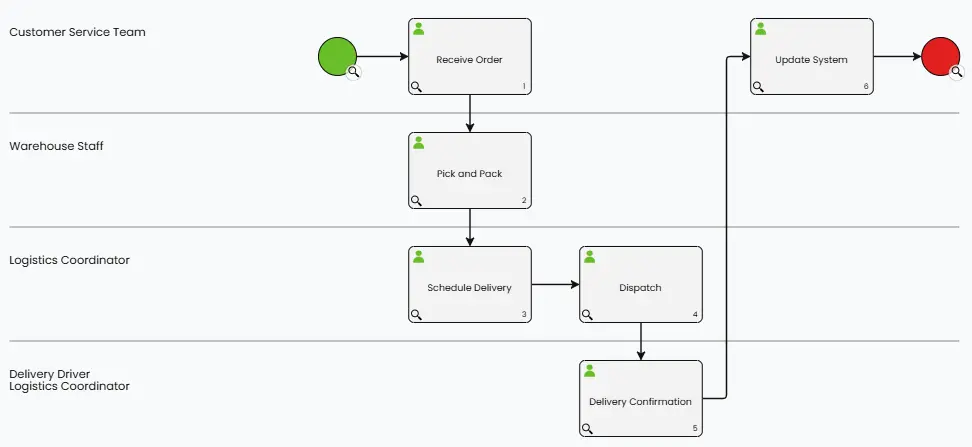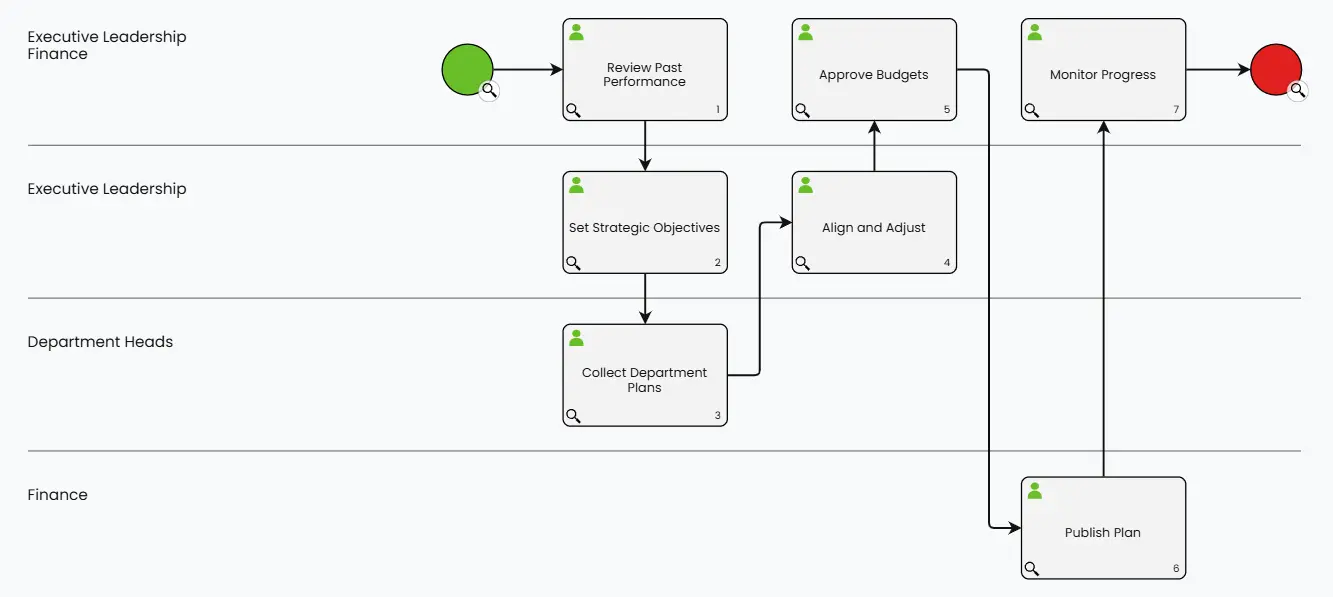Every organization runs on different types of business processes that determine how work is done, managed, and improved. Some deliver value to customers, others support your teams behind the scenes, and a third group focuses on planning and improvement.
When you understand these 3 types, it becomes easier to manage work, fix weak areas, improve performance, and keep things running smoothly. This clarity lets you set standards and find opportunities to streamline while making the best use of time and resources.
This guide explains the three main types of business processes and shows how they work together. It also covers the tools that help you manage them all in one place.
TL;DR - Types of business processes
Every business runs on three main types of processes: operational, supporting, and management.
Operational processes create customer value and generate revenue.
Supporting processes keep internal operations running smoothly.
Management processes plan, monitor, and improve how the business performs.
Understanding these types helps you spot inefficiencies, fix weak points, and improve collaboration. With a tool like ProcessPro, you can map, manage, and optimize all three in one place—cutting errors, improving speed, and scaling with confidence.
What are business processes and why they matter
A business process is a set of steps your company follows to reach a goal, which can be simple or complex and often involves multiple teams working together.
Business processes turn inputs like time, money, materials, or information into outputs such as products or services.
Some examples:
- Hiring a new employee
- Approving an invoice
- Delivering a product to a customer
Clear processes keep work the same every time. Everyone knows what to do and who is responsible. This shared clarity shows how steps connect across the business.
This approach cuts mistakes, speeds up work, and improves results.
Operations managers use tools to document and manage processes in one place, replacing scattered spreadsheets and endless email threads with a single source of truth.
To optimize your types of business processes, start by calculating process cycle time. Divide total steps by outputs. This reveals hidden problems before they impact your products or services.

Understanding the types of business processes
Understanding the types of business processes helps you work better by showing what drives value, what supports it, and what keeps things on track. Without this clarity, teams work in isolation, waste time, and miss opportunities to improve.
Here’s what changes when you know your process types:
Spot gaps and delays fast to make problems easy to see.
Cut steps that don’t add value to save money.
Make fewer mistakes with clear steps that guide everyone.
Decide faster with clear roles and stay compliant with better tracking.
Find opportunities to improve efficiency by mapping steps.
Work together better by making everyone’s role visible.
- Operations managers can map and track all of this in one dashboard and leaders can see how work flows across teams.
Benchmark your types of business processes against industry standards. Use APQC* metrics to measure gains. You can quantify benefits like 15-20% cost savings. These come from clearer roles and better compliance tracking.

Types of business processes: The 3 core categories explained with examples
All organizations needs three main types of business processes. These are operational, supporting, and management.
They give you a clear framework to set standards, find weak spots, and plan fixes.
The three types cover all business activities. Operational processes create customer value. Supporting processes keep internal work running. Management processes plan and watch everything. This keeps you aligned with goals.
At a glance: The three core types of business processes
Here’s a quick overview of how each process type contributes to business performance.
| Type | Focus | Key Examples | Pro Tip Snippet |
|---|---|---|---|
| Operational | Create direct customer value and revenue | Making products/services, Marketing/selling, Delivering to customers, After-sales support | Track operational types of business processes using throughput KPIs (e.g., orders fulfilled per hour). Aim for under 5% error rates to protect customer value. |
| Supporting | Enable internal operations and teams | Payroll/employee tasks, IT support/maintenance, Buying supplies/facilities, Finance reports/compliance | For supporting types of business processes like HR or IT, implement SLAs (e.g., 95% on-time payroll) to keep your operational engine humming. |
| Management | Plan, measure, and guide overall activities | Planning strategy/budgets, Tracking sales/performance, Managing risk/compliance, Running improvement projects | Enhance management types of business processes with OKRs. Review quarterly to adapt strategies and boost resource alignment. |
Visualize your types of business processes with a simple RACI matrix (Responsible, Accountable, Consulted, Informed) to align operational, supporting, and management activities from day one.
Operational processes
Operational processes, also called core processes, create value for customers, bring in money, and form the backbone of your value chain. Examples include making products or services, marketing and selling, delivering to customers, and giving after-sales support.
Track operational types of business processes using throughput KPIs and measure orders fulfilled per hour to ensure delays don’t hurt customer value. Aim for under 5% error rates.
Delivering to customers: operational process example

Supporting processes
Supporting processes don’t make money directly, but they make operational processes work and serve internal teams, not customers. Examples include payroll and employee tasks, IT support and maintenance, buying supplies and managing facilities, and finance reports and compliance.
HR doesn’t sell products, but without hiring the right people, sales and production can’t work. Supporting processes keep your engine running.
You can standardize these processes using clear steps, manage requests easily, and track approvals so operations keep moving.
For supporting types of business processes like HR or IT, implement SLAs. SLAs are Service Level Agreements. Set targets like 95% on-time payroll processing. This keeps your operational engine running smoothly.
Payroll and employee tasks: supporting process example

Management processes
Management processes guide and control other activities by focusing on planning, measuring, and improving how your business runs. Examples include planning strategy and budgets, tracking sales and performance, managing risk and compliance, and running improvement projects.
These don’t make money directly but keep everything aligned with your goals. Strong management processes also help you adapt, use resources well, and stay compliant.
Managers can oversee key processes in one system, set targets, and see data live so decisions get faster and better.
Enhance management types of business processes by adding OKRs. OKRs are Objectives and Key Results. Build them into your tracking. Review quarterly to adapt strategies. This boosts resource alignment.
Planning strategy and budgets: management process example

How to create operational processes for a company
Knowing the types of business processes is step one, and step two is putting clear operational processes in place. Strong processes keep work consistent, improving quality, speed, and reliability. Follow these steps to create them for your company:
1. Find core activities
List what creates value for customers, such as making products, delivering services, and marketing or sales.
2. Map the steps
Write out each step, noting who does what, what’s needed, and what comes out. This stops confusion.
3. Write down who does what
Give each step an owner, specify who is responsible, and explain how work moves between people.
4. Set standards
Define what good looks like for each step, including timelines, accuracy levels, and approval rules. These standards keep things consistent.
5. Build it in a system
Spreadsheets and emails get messy fast. A good process management tool lets you build processes digitally, assign tasks, track progress in real time, and keep everything organized. For example, ProcessPro gives you a centralized platform to map processes, assign responsibilities, and monitor every step, creating visibility and accountability across your entire organization.
6. Train everyone
Share the new process and train your team so everyone understands their role and what’s expected of them.
7. Watch and improve
Processes aren’t static; they need regular review and refinement to stay effective. Review them often to catch bottlenecks, remove unnecessary steps, and track performance over time.
How ProcessPro helps you improve processes
With ProcessPro, you can update and improve processes without starting from scratch. Use SmartFlow to draft new processes, refine existing ones, and identify weak areas.
The platform includes built-in tools to:
- Explore process ideas
- Optimize processes
- Run health checks and risk analysis
- Create executive summaries
- Suggest process groupings
- Generate SOPs
This creates a living system where your processes stay accurate, efficient, and aligned with business goals.
Strong operational processes give you a solid foundation. They eliminate guesswork, reduce errors, and make scaling easier.
Examples of operational business processes in action
Real examples help you understand how good processes work by improving speed, cutting errors, and making customers happier.
1: Order-to-cash in retail
A retail company runs its order-to-cash process across many teams. Sales, inventory, finance, and shipping all play a part.
By mapping this as one process, the team:
- Set up automatic alerts for approvals
- Made invoices and tracking standard
- Cut order time by 25%
- Saw everything across departments
2: Employee onboarding in a service business
A consulting firm wanted faster onboarding. HR, IT, legal, and operations all had steps.
By building the onboarding process systematically, they:
- Wrote down every step from contract to desk setup
- Gave people tasks with due dates
- Used templates for repeat tasks
- Cut onboarding from two weeks to five days
3: Invoice approval in finance
A manufacturing company had slow approvals. Finance used email threads. Department heads checked documents by hand.
By moving to a structured process, they:
- Put all invoices in one place
- Routed approvals through ProcessPro automatically
- Tracked times in one dashboard
- Stopped all late payment fees
4: Customer support escalations
A software company had slow response times. Complex tickets took too long. People escalated through chat messages.
The team formalized the process by routing tickets to the right experts, tracking updates live, cutting resolution time by 40%, and ensuring consistent service quality.
These examples show that operational processes often cross teams. When structured well, they become faster, more reliable, and easier to manage.
Adapt these operational examples by A/B testing variations. Try digital vs. manual approvals. This refines your types of business processes. Expect 10-30% efficiency gains based on real-world pilots.
Related business functions
Linking types of business processes to business functions makes them easier to understand. Every function uses operational, supporting, and management processes.
Sales (Operational):
Sales directly deliver value to customers and drives revenue. Its processes include lead qualifications, proposals, follow-ups, and closing deals.
Customer Service (Supporting):
This function supports operational processes by maintaining customer relationships and protecting your brand. Processes cover handling questions, resolving complaints, and providing after-sales support.
Finance (Supporting + Management):
Finance supports operations through invoicing and payroll, while also handling management processes like budgeting, financial reporting, and compliance monitoring.
Operations (Operational):
Daily activities like purchasing, production scheduling, logistics, and supply chain management are core operational processes that deliver products or services.
Production (Operational):
Manufacturing or creating products is a key operational process that directly creates customer value.
Marketing (Supporting):
Marketing supports sales operations by creating demand and brand awareness. Processes include campaign planning, content creation, and performance analysis.
Human Resources (Supporting):
HR supports all functions through hiring, onboarding, payroll, training, and employee engagement processes.
Management (Management):
Strategic planning, performance monitoring, goal setting, and process improvement fall under management processes across all departments.
You can map all functions and their processes in one system. This makes handoffs clear, shows weak spots, and reveals where improvements help most.
Cross-mapping functions to types of business processes helps you spot silos. For example, linking marketing’s supporting role to sales’ operational flow creates seamless handoffs and better results.
Key takeaways
Knowing the three types of business processes helps you see what creates value and how work connects across your organization. Good processes reduce friction by spotting bottlenecks faster, reducing errors, and improving team collaboration. Centralized process management matters too, so use a platform like ProcessPro to manage everything in one place. Start with structure, apply the 80/20 rule, choose the right tools, and build for adaptability to respond to change more effectively.
Frequently asked questions
Your quick reference for understanding business process basics.
What are the main types of business processes?
The main types are operational, supporting, and management.
Operational processes create value for customers and bring in money. Supporting processes serve internal teams, making operational work possible. Management processes plan and control activities to keep everything lined up with business goals.
Some models have a fourth type. Strategic processes focus on long-term direction and innovation.
What are examples of the different types of business processes?
Operational: product development, marketing, sales, order fulfillment, customer support
Supporting: payroll, IT support, procurement, facilities management, finance reporting
Management: budgeting, performance tracking, risk management, strategic planning
These examples show how process types work together. They keep your business running well.
How do you create operational types of business processes?
To create operational processes:
- Find the key activities that deliver value to customers.
- Map each step clearly. Show roles and responsibilities.
- Set quality standards for outputs.
- Use a process management tool to organize everything in one place.
- Check and improve the process often to keep it working well.
What are the 4 types of business processes?
Some frameworks use four categories:
- Operational – Core activities that create value for customers.
- Supporting – Internal processes that enable operations.
- Management – Activities that plan and guide the business.
- Strategic – High-level processes for innovation and future direction.
When exploring the 4 types of business processes, audit your strategic layer annually. Use SWOT analysis. This ensures innovation aligns with operational and supporting foundations.
Ready to streamline your business processes?
Identifying the types of business processes is only the first step. The real impact comes when you put them into action.
ProcessPro gives you one place to map, manage, and improve all your operational, supporting, and management processes. No more scattered spreadsheets. No more confusion about who does what. Just clear visibility and control.
See how ProcessPro works for your business. Book a demo today and discover how easy process management can be.

James Ross
Founder & CEO. James is passionate about all thing Process Mapping and sharing his wealth of experience with his valued clients. He works closely with his teams to ensure that ProcessPro solves real everyday process mapping problems.
Share this article
